Improving the Microstructure and Mechanical Properties of Laser-Welded Al–Si-Coated 22MnB5/Galvanized Steel Joints Added by Nickel
Abstract
:1. Introduction
2. Experimental Materials and Procedures
3. Results and Discussion
3.1. Weld Appearance
3.2. Microstructure
3.3. Mechanical Properties
4. Conclusions
Author Contributions
Funding
Data Availability Statement
Acknowledgments
Conflicts of Interest
References
- Hammarberg, S.; Kajberg, J.; Larsson, S. Ultra high strength steel sandwich for lightweight applications. SN Appl. Sci. 2020, 2, 1040. [Google Scholar] [CrossRef]
- Zhang, T.L.; Wang, W.G.; Ma, Y.M.; Fang, N.W.; Lin, S.B.; Li, Z.X.; Kou, S. In situ observation of microstructural and inclusions evolution in high-strength steel deposited metals with various rare earth Pr contents. J. Mater. 2022, 15, 1257. [Google Scholar] [CrossRef]
- Schmitt, J.H.; Iung, T. New Developments of Advanced High-Strength Steels for Automotive Applications. C. R. Phys. 2018, 19, 641–656. [Google Scholar] [CrossRef]
- Karbasian, H.; Tekkaya, A.E. A Review on Hot Stamping. J. Mater. Process. Technol. 2010, 210, 2103–2118. [Google Scholar] [CrossRef]
- Mori, K.; Ito, D. Prevention of Oxidation in Hot Stamping of Quenchable Steel Sheet by Oxidation Preventive Oil. CIRP Ann. Manuf. Technol. 2009, 58, 267–270. [Google Scholar] [CrossRef]
- Ighodaro, O.L.; Biro, E.; Zhou, Y.N. Comparative Effects of Al-Si and Galvannealed Coatings on the Properties of Resistance SpotWelded Hot Stamping Steel Joints. J. Mater. Process. Technol. 2016, 236, 64–72. [Google Scholar] [CrossRef]
- Viňáš, J.; Brezinová, J.; Brezina, J. Structural and Mechanical Features of Laser-Welded Joints of Zinc-Coated Advanced Steel Sheets. Mater Sci 2019, 55, 46–51. [Google Scholar] [CrossRef]
- Zhao, H.Y.; Huang, R.R.; Sun, Y.M. Microstructure and mechanical properties of fiber laser welded QP980/press-hardened 22MnB5 steel joint. J. Mater. Process. Technol. 2020, 9, 10079–10090. [Google Scholar] [CrossRef]
- Sun, Q.; Di, H.S.; Wang, X.N.; Chen, X.M. Suppression of δ-ferrite formation on Al-Si coated press-hardened steel during laser welding. Mater. Lett. 2019, 245, 106–109. [Google Scholar] [CrossRef]
- Jia, J.; Yang, S.L.; Ni, W.Y.; Bai, J.Y. Microstructure and Mechanical Properties of fiber Laser Welded Joints of Ultrahigh-Strength Steel 22MnB5 and Dual-Phase Steels. J. Mater. Res. 2014, 29, 2565–2575. [Google Scholar] [CrossRef]
- Li, Y.L.; Liu, Y.R.; Yang, J. First Principle Calculations and Mechanical Properties of the Intermetallic Compounds in a Laser Welded Steel/Aluminum Joint. Opt. Laser Technol. 2020, 122, 105875. [Google Scholar] [CrossRef]
- Zhou, D.W.; Xu, S.H.; Peng, L.; Liu, J.S. Laser lap Welding Quality of Steel/Aluminum Dissimilar Metal Joint and its Electronic Simulations. Int. J. Adv. Manuf. Technol. 2016, 86, 2231–2242. [Google Scholar] [CrossRef]
- Kim, C.; Kang, M.J.; Park, Y.D. Laser welding of Al-Si coated hot stamping steel. Pro. Eng. 2011, 10, 2226–2231. [Google Scholar] [CrossRef]
- Lin, W.H.; Li, F.; Wu, D.S.; Chen, X.G.; Hua, X.M.; Pan, H. Effect of Al-Si coating on weld microstructure and properties of 22MnB5 steel joints for hot stamping. J. Mater. Eng. Perform. 2017, 27, 1825–1836. [Google Scholar] [CrossRef]
- Saha, D.C.; Biro, E.; Gerlich, A.P.; Zhou, Y.N. Fusion zone microstructure evolution of fiber laser welded press hardened steels. Scr. Mater. 2016, 121, 18–22. [Google Scholar] [CrossRef]
- Lin, W.H.; Li, F.; Hua, X. Effect of filler wire on laser welded blanks of Al-Si-coated 22MnB5 steel. J. Mater. Process. Technol. 2018, 259, 195–205. [Google Scholar] [CrossRef]
- Völkers, S.; Somonov, V.; Böhm, H.C.S. Influence on the Microstructure of Laser Beam Welds of High-strength Steels. J. Lightweight Worldw 2017, 10, 40–45. [Google Scholar] [CrossRef]
- Khan, M.S.; Razmpoosh, M.H.; Macwan, A. Optimizing weld morphology and mechanical properties of laser welded Al-Si coated 22MnB5 by surface application of colloidal graphite. J. Mater. Process. Technol. 2021, 293, 117093. [Google Scholar] [CrossRef]
- He, X.; Qin, Y.Q.; Jiang, W.X. Effect of Welding Parameters on Microstructure and Mechanical Properties of Laser Welded Al-Si Coated 22MnB5 hot Stamping Steel. J. Mater. Process. Technol. 2019, 270, 285–290. [Google Scholar] [CrossRef]
- Zhang, D.F.; Qin, Y.Q.; Zhao, F.; Liang, M. Microstructure and Mechanical Properties of Laser Welded Al-Si Coated 22MnB5 hot Stamping Steel and Galvanized Steel. J. Mater. Eng. Perform. 2021, 31, 1346. [Google Scholar] [CrossRef]
- Razmpoosh, M.H.; Macwan, A.; Biro, E.; Zhou, Y. Microstructure and dynamic tensile characteristics of dissimilar fiber laser welded advanced high strength steels. Mater. Sci. Eng. A-Struct. 2020, 773, 138729. [Google Scholar] [CrossRef]
- Min, S.L.; Moon, J.H.; Kang, C.G. Investigation of formability and surface micro-crack in hot deep drawing by using laser-welded blank of Al–Si and Zn-coated boron steel. J. Eng. Manuf. 2014, 228, 540–552. [Google Scholar]
- Zhao, F.; Qin, Y.Q.; Zhang, D.F. Effect of Filler Wire on Laser Lap Welding of Al-Si Coated 22MnB5 Hot Stamping Steel. J. Mater. Eng. Perform. 2022, 31, 9670–9680. [Google Scholar] [CrossRef]
- Yao, Z.; Xu, G.; Jiang, Z. Effects of Ni and Cr on Cryogenic Impact Toughness of Bainite/Martensite Multiphase Steels. Met. Mater. Int. 2019, 25, 1151–1160. [Google Scholar] [CrossRef]
- Khan, M.S.; Razmpoosh, M.H.; Biro, E. α-Ferrite Suppression during Fiber Laser Welding of Al-Si Coated 22MnB5 Press-Hardened Steel. Weld. J. 2021, 100, 213–220. [Google Scholar] [CrossRef]

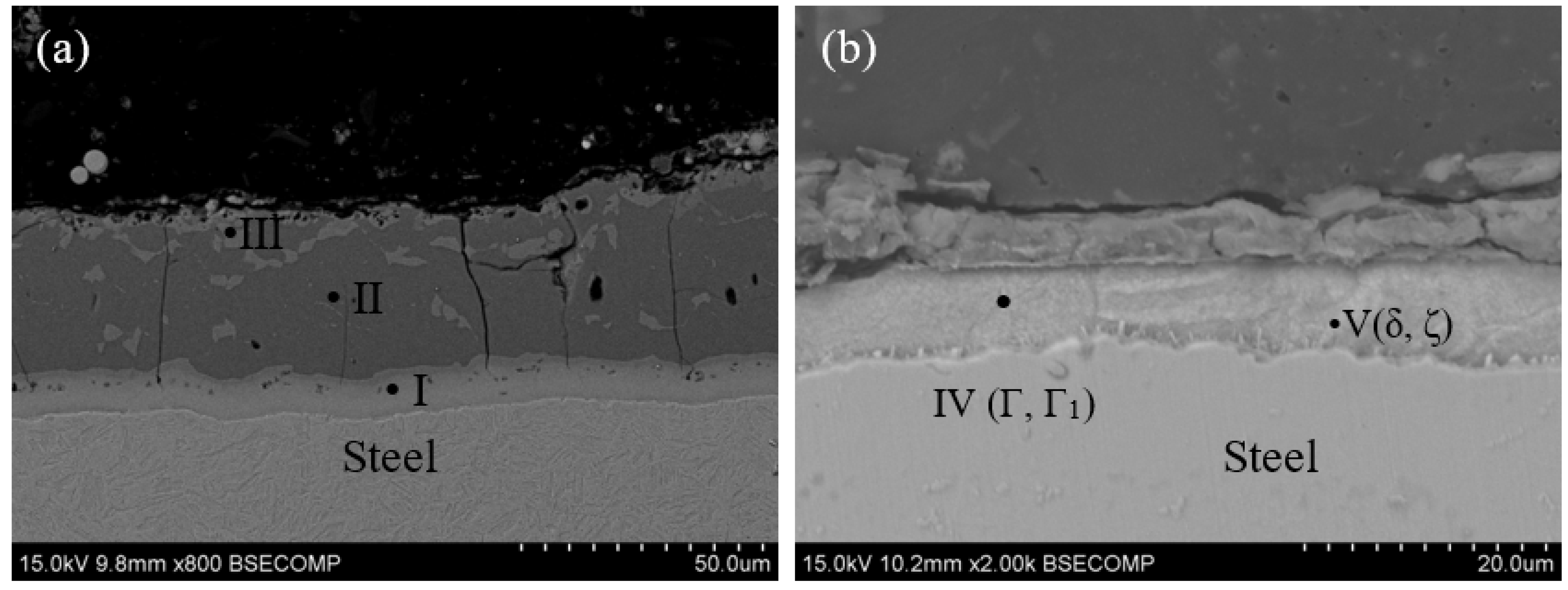
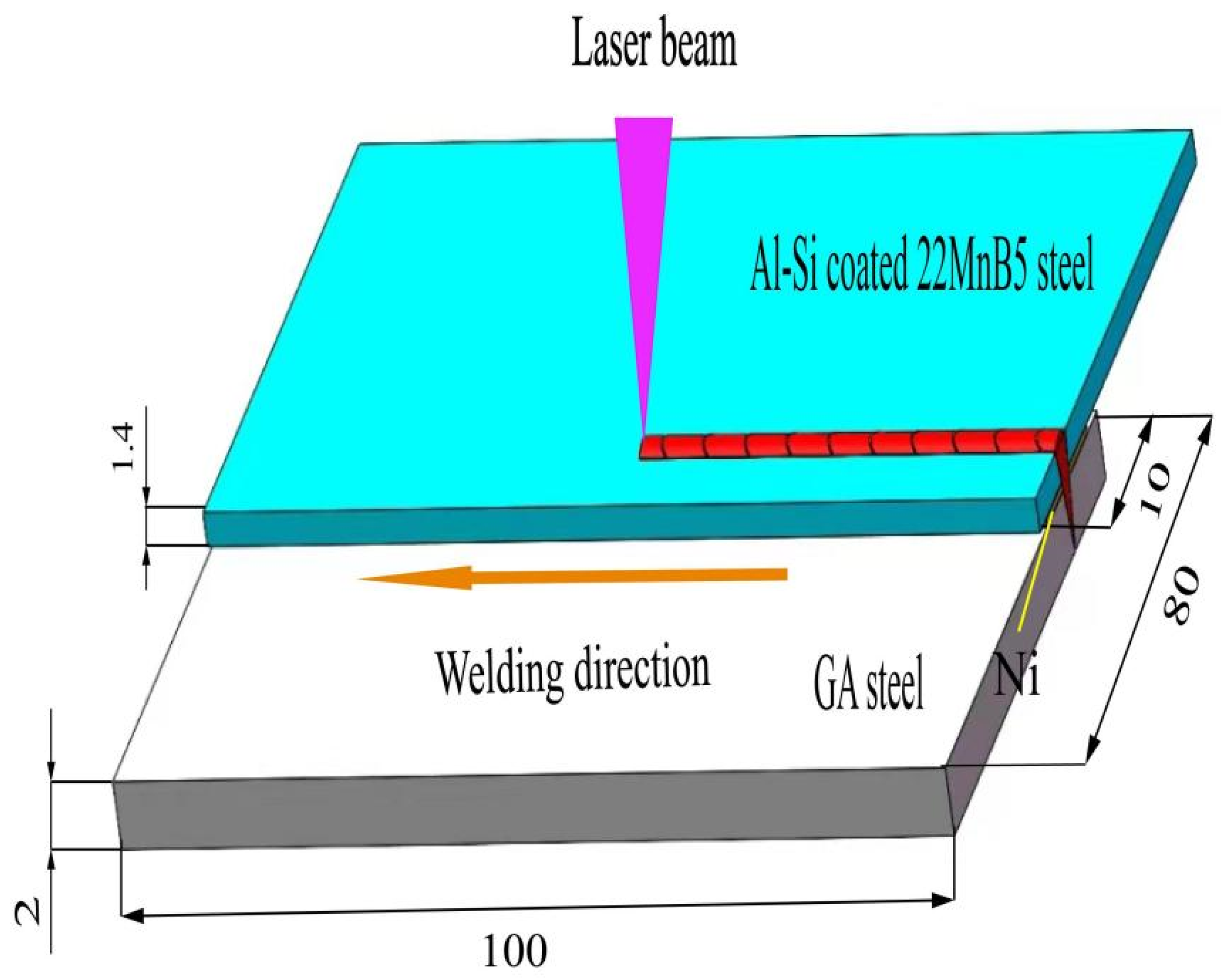
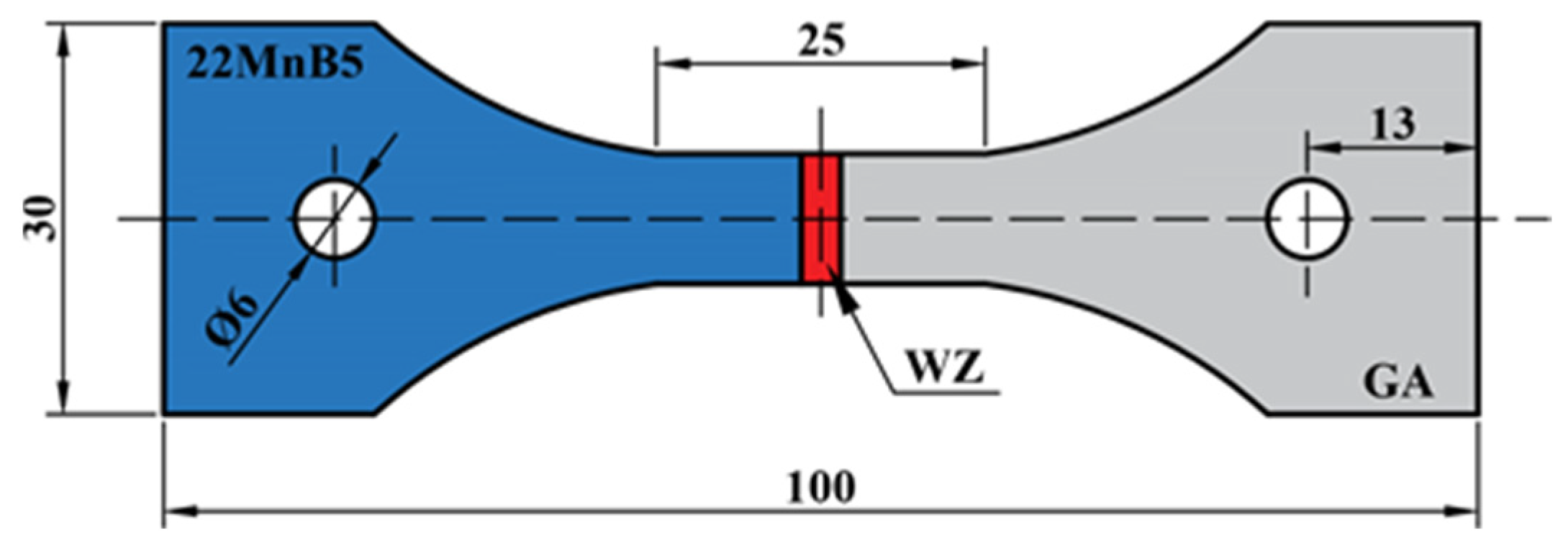

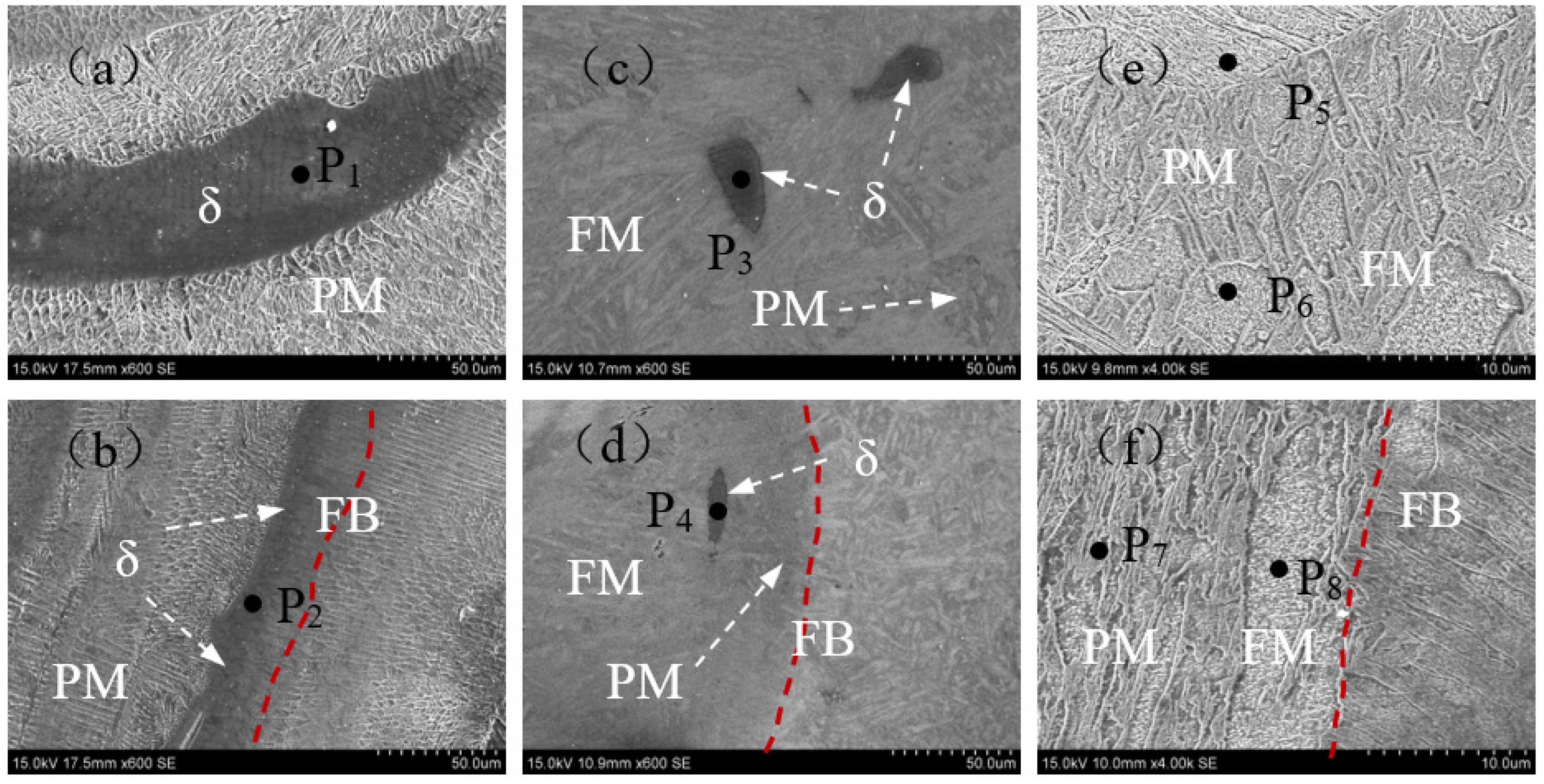
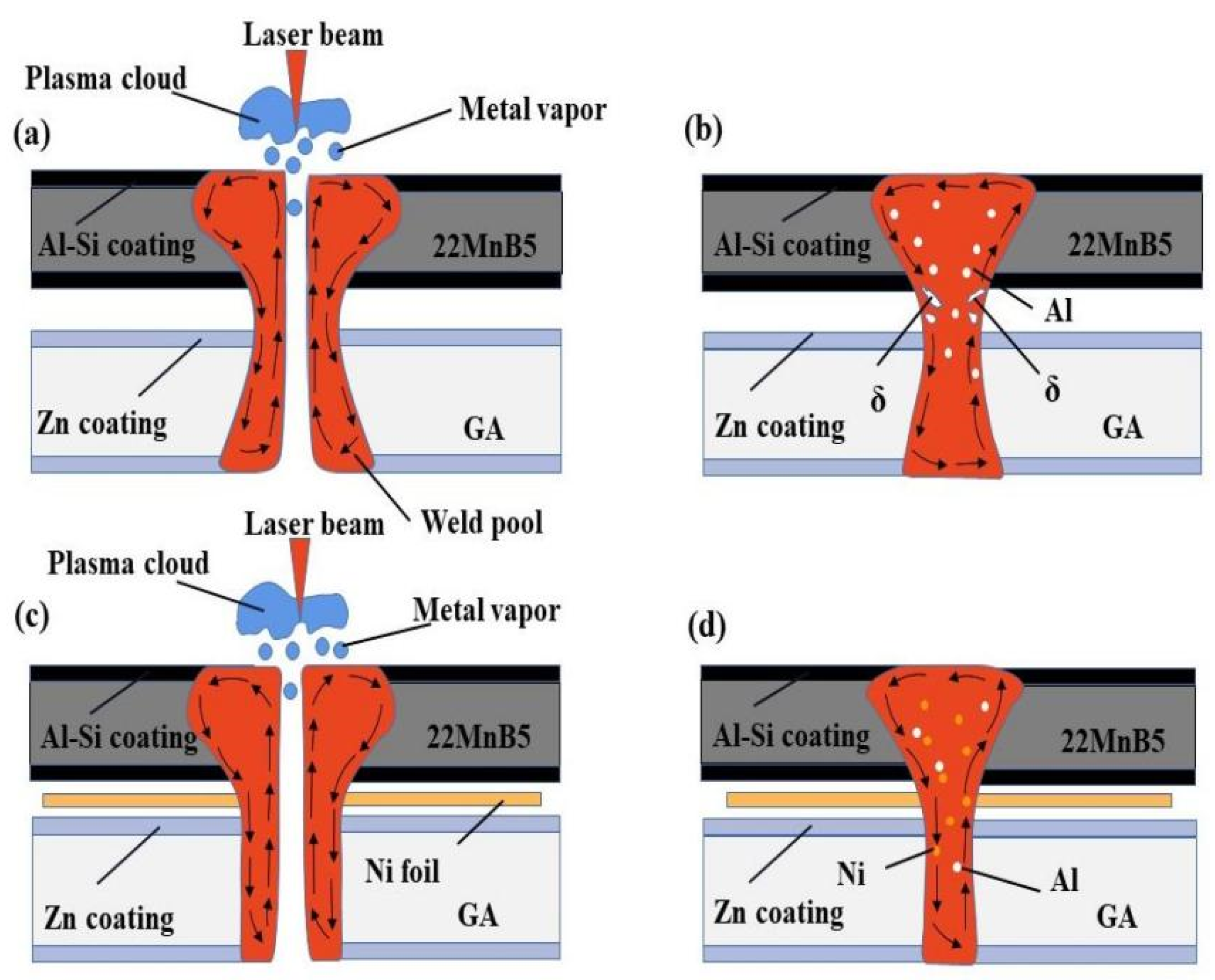
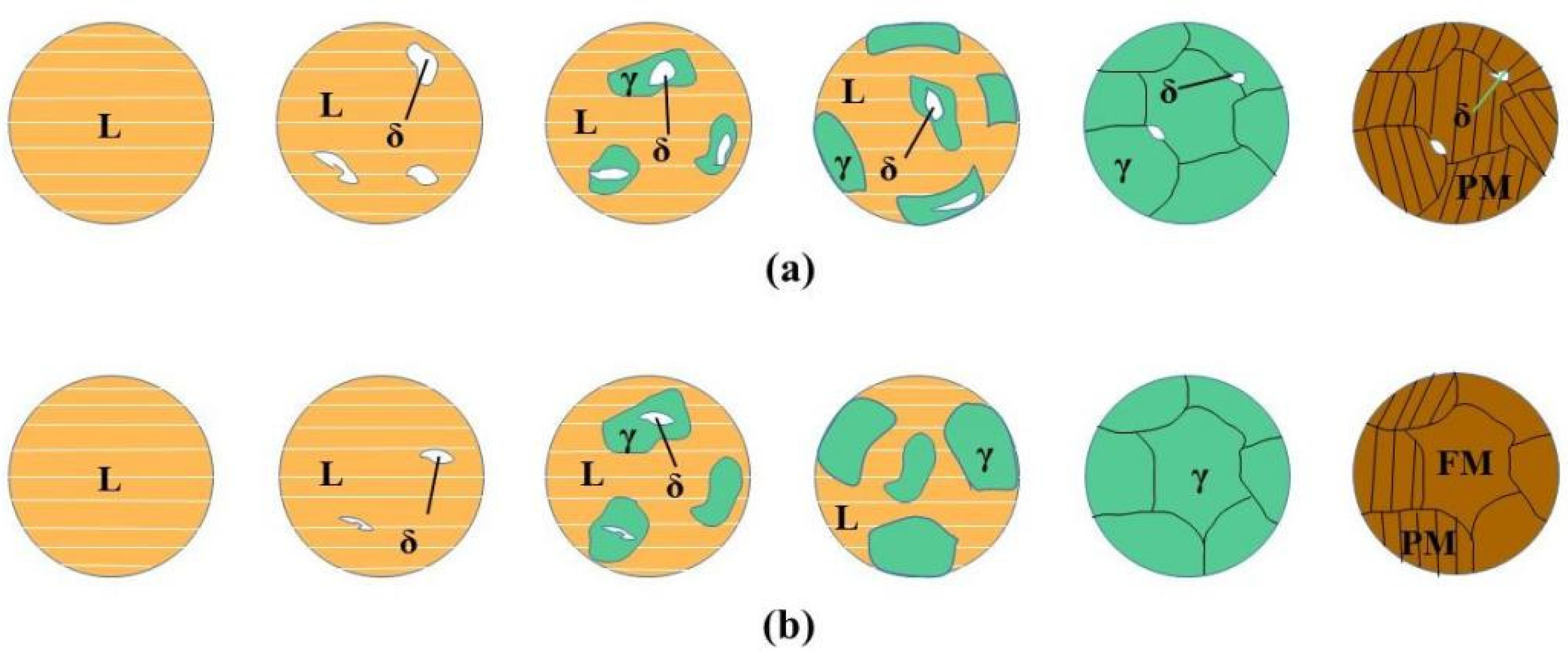
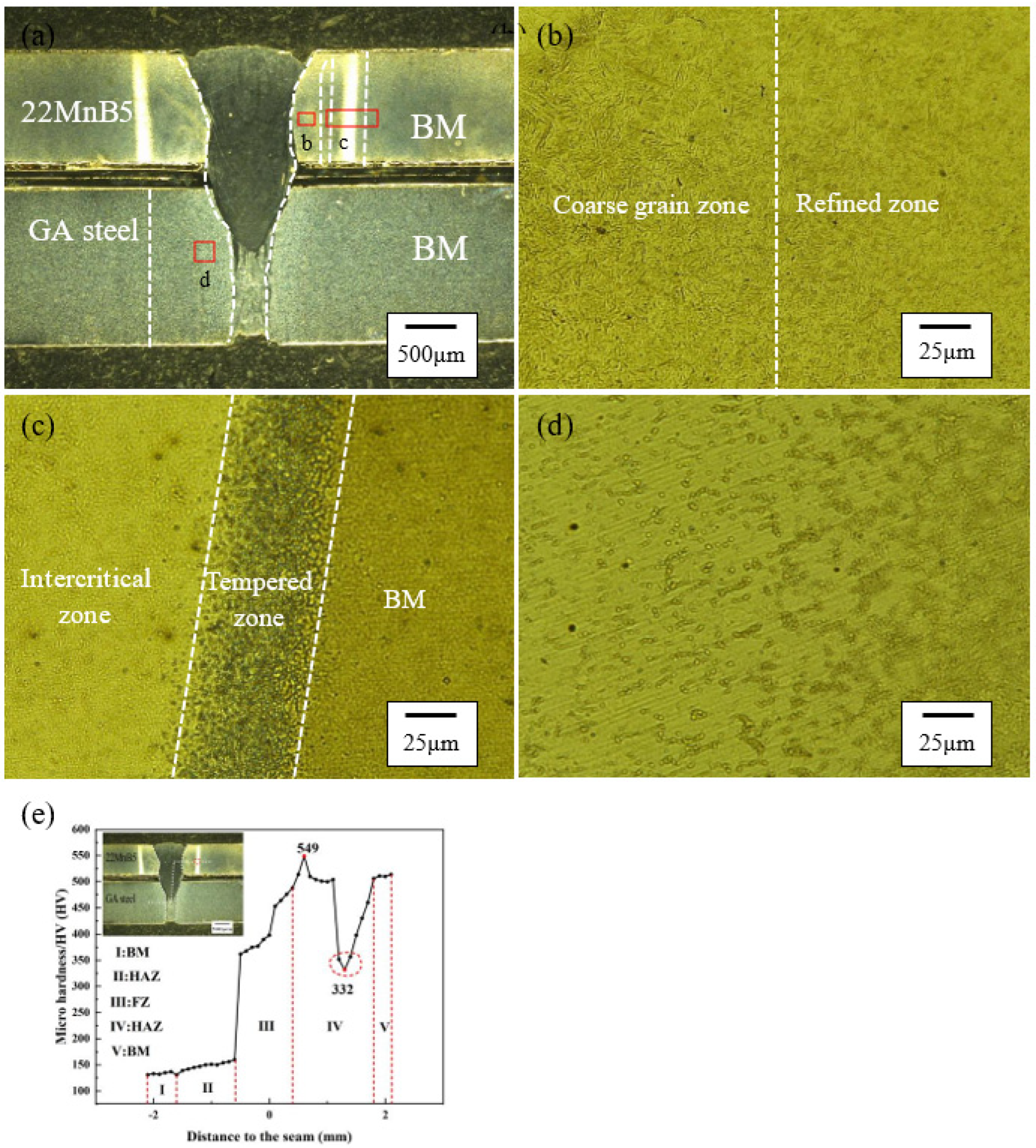
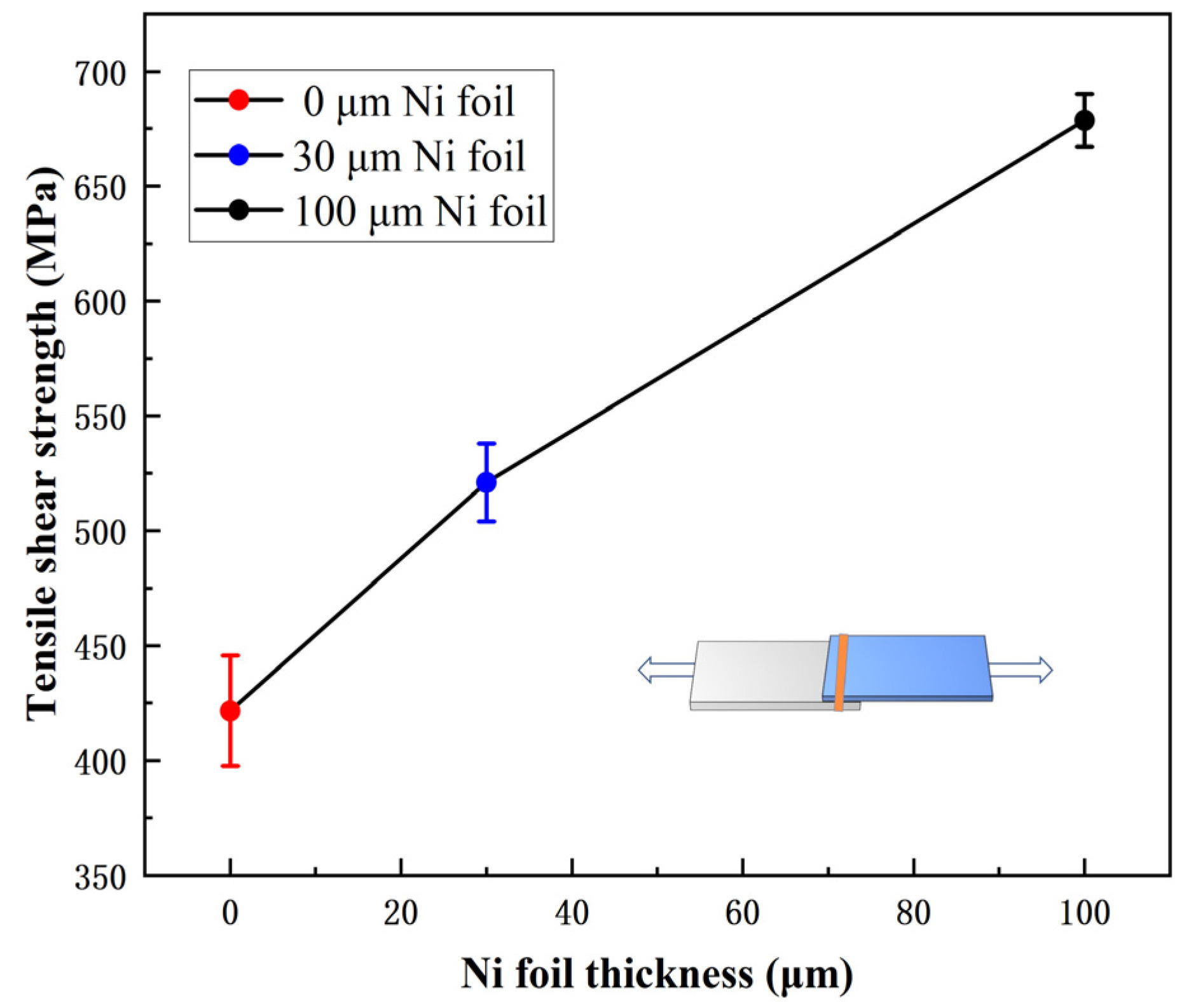

| Chemical Compositions (wt.%) | Tensile Properties | ||||||||||
|---|---|---|---|---|---|---|---|---|---|---|---|
| BM | C | Mn | Si | Cr | B | Ti | Al | Fe | UTS (Mpa) | YS (Mpa) | Elongations (%) |
| 22MnB5 | 0.23 | 1.13 | 0.27 | 0.16 | 0.0025 | 0.038 | 0.037 | Bal | 1500 | 1200 | 4.1 |
| GA steel | 0.041 | 0.187 | 0.018 | 0.04 | — | 0.011 | 0.0032 | Bal | 350 | 300 | 11.5 |
| No. | Laser Power (kW) | Welding Speed (m·min−1) | Ni Foil Thickness (μm) | B1 (mm) | B2 (mm) | B3 (mm) | Cross-Section |
|---|---|---|---|---|---|---|---|
| 1 | 3 | 2 | — | 1.61 | 1.25 | 1.12 | 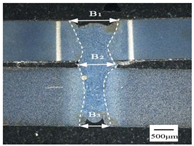 |
| 2 | 3 | 2 | 30 | 1.57 | 1.03 | 0.67 | 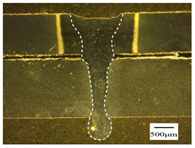 |
| 3 | 3 | 2 | 100 | 1.55 | 1.08 | 0.51 | 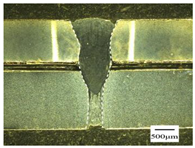 |
| Component/wt.% | P1 | P2 | P3 | P4 | P5 | P6 | P7 | P8 |
|---|---|---|---|---|---|---|---|---|
| Al | 7.65 | 6.73 | 3.76 | 3.11 | 0.72 | 0.63 | 0.86 | 0.90 |
| Si | 0.98 | 0.75 | 0.89 | 0.54 | 0.46 | 0.23 | 0.31 | 0.02 |
| Ni | 0.12 | 0.18 | 2.72 | 1.40 | 1.35 | 4.81 | 1.42 | 3.27 |
| Fe | Bal. | Bal. | Bal. | Bal. | Bal. | Bal. | Bal. | Bal. |
| Zone | Critical Temperature | Phase Transition Process | |
|---|---|---|---|
| heat affected zone (22MnB5) | Coarse grain zone | Ac3 < T < 1100 °C | M → γ → M |
| Refined zone | 1100 °C < T < TL | ||
| Incompletely quenched zone | Ac1 < T < Ac3 | M → γ + α-Fe → M + α-Fe | |
| Tempering zone | Ttemper < T < Ac1 | M → TM | |
| heat affected zone (GA) | Incompletely recrystallized zone | Ac1 < T | α-Fe + P → γ + α-Fe + P → F + P |
| NO | Ni Foil Thickness (μm) | Tensile Shear Load (N) | Section Size B × H (mm2) | Tensile Shear Strength (MPa) | Fracture Location |
|---|---|---|---|---|---|
| 0 | _ | 4569 | 1.1 × 10 | 412 | FB |
| 1 | 30 | 6242 | 1.2 × 10 | 521 | FB |
| 2 | 100 | 6245 | 0.92 × 10 | 679 | Interface |
| Element/wt.% | E1 | E2 | E3 | E4 | E5 | E6 |
|---|---|---|---|---|---|---|
| Al | 8.07 | 3.05 | 1.12 | 2.04 | 1.08 | 0.30 |
| Si | 0.65 | 0.71 | 0.52 | 0.74 | 0.88 | 0.16 |
| Ni | — | — | — | 1.44 | 2.59 | 8.07 |
| Fe | Bal. | Bal. | Bal. | Bal. | Bal. | Bal. |
Disclaimer/Publisher’s Note: The statements, opinions and data contained in all publications are solely those of the individual author(s) and contributor(s) and not of MDPI and/or the editor(s). MDPI and/or the editor(s) disclaim responsibility for any injury to people or property resulting from any ideas, methods, instructions or products referred to in the content. |
© 2023 by the authors. Licensee MDPI, Basel, Switzerland. This article is an open access article distributed under the terms and conditions of the Creative Commons Attribution (CC BY) license (https://creativecommons.org/licenses/by/4.0/).
Share and Cite
Zhang, Y.; Qin, Y.; Zhao, F.; Liang, M. Improving the Microstructure and Mechanical Properties of Laser-Welded Al–Si-Coated 22MnB5/Galvanized Steel Joints Added by Nickel. Metals 2023, 13, 1600. https://doi.org/10.3390/met13091600
Zhang Y, Qin Y, Zhao F, Liang M. Improving the Microstructure and Mechanical Properties of Laser-Welded Al–Si-Coated 22MnB5/Galvanized Steel Joints Added by Nickel. Metals. 2023; 13(9):1600. https://doi.org/10.3390/met13091600
Chicago/Turabian StyleZhang, Youping, Youqiong Qin, Feng Zhao, and Min Liang. 2023. "Improving the Microstructure and Mechanical Properties of Laser-Welded Al–Si-Coated 22MnB5/Galvanized Steel Joints Added by Nickel" Metals 13, no. 9: 1600. https://doi.org/10.3390/met13091600




